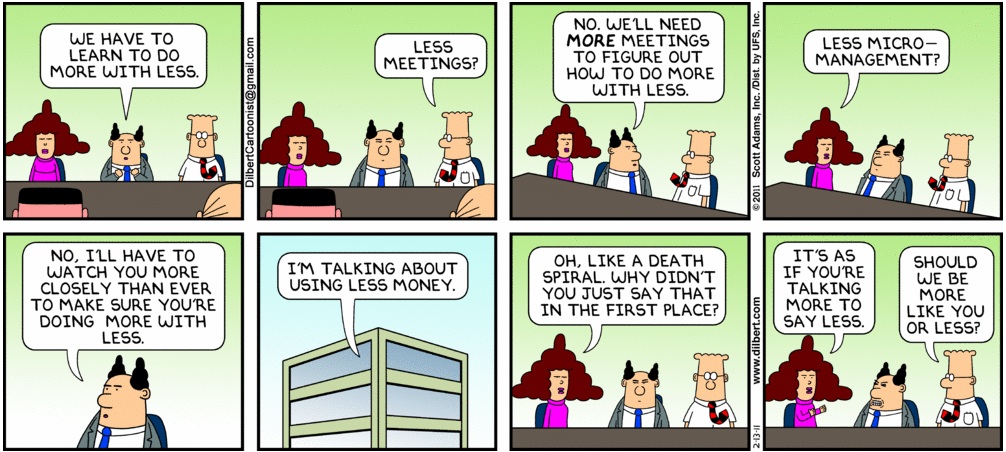
Why IT Has to Do More with Less Every Single Year
In IT, one of our biggest (maybe even our favorite?) grumble, every year, is how the business expects us to deliver more for less. So why is that? Perhaps there’s one overriding reason why the business expects it: IT has, by and large, delivered exactly that for the last 50 years or so. From inside IT, we’re very aware how hard it is to deliver these constant improvements in times of budget cuts and austerity. But step outside IT, take a wider perspective and you’d agree that your customers just see technology driving savings and the IT department offering more and better services than ever before.
So the way I see it – this never-ending demand for always better and also cheaper services is actually a massive compliment and recognition of our success! Because we’ve delivered for so many years, our customers now presume that we can do it again. So, we can’t complain about being complimented, we sort of just have to deliver.
Understanding how we got on this non-stop treadmill is important. Once we understand the situation, we can do something to help us keep running fast enough to stay on it and not get catapulted off. If we spread that understanding to our customers, we may even get them to turn the speed down a little.

All Down to the Onward March of Technology
At the root of this are the spectacular technological innovations we’ve seen throughout IT’s history. Going from floppy disks to cloud hasn’t taken that long and every step has facilitated increased accuracy, price, and a better IT infrastructure to build services on.
But, for those of us focused on service provision, technology is only one part of the famous triple foundation of services. We also have to rely on people and process to create and maintain relevant quality services. While technology remains an ongoing source of innovation and progress, the other two parts – people and process – are human-based and therefore cannot be expected to deliver change, innovation or, crucially, cost savings at the same fast-paced rate.
That puts those of us in IT service management (ITSM) in something of a catch-22 situation. Our position within IT means that our customers expect that never-ending IT scale of improvement to quality and reduction in cost. That gives the ITSM community the biggest challenge in IT, and therefore, of course, also the biggest opportunities.
What Can We Do About It?
It isn’t all bad news actually. Let’s take a look at the situation, see how we can address it in order to identify and justify opportunities for improvement.
The Holistic ‘DevOps’ View
The DevOps cultural approach encompasses good ideas from a range of sources, and offers many benefits to an organization. But let’s stick to the basic idea of merging Development and Operations (hence the name). Seeing developing of services as separate from supporting their ongoing delivery leads to measuring those activities separately, and therefore setting distinct measures of success. Instead, an overall and simply expressed goal – of how useful services are – is the best way, neither rewarding development for overall technological improvement nor hobbling operations working with slower changing human elements.
The basic DevOps approach means working as one, all in this together, one set of metrics and we all succeed, or we all fail. This approach is fundamental to measuring the right things and being seen to deliver what the customers need.
Customer Awareness and Education
Customers and users of IT services are every bit as clever as IT people – but may not be aware, nor even remotely interested, in IT innovations. But they do see their smart phones and tablets doing more for less money every year. ITSM needs to show that equivalent improvements are offered in the workplace too, but judgement should be across the whole service.
Realize It Yourself
Quite obviously, the first step to resolution of any issue is to comprehend it. Look for yourself at how things are changing in your organization – specifically think about:
- The improvements technology has delivered for your customers.
- What your customers’ expectations for next year’s performance might be, based on how you’ve improved. They’ll look at how useful your services have been to them in their work and how that “usefulness” has improved over time, which will drive how they expect it to keep improving in the future.
- How improvements to personal skills and procedures do deliver benefits, but typically in smaller steps than technology.
Realize also that this isn’t just an IT issue. We, as customers ourselves, get so much more now from many services we use, especially the ones underpinned by technologies, such as power, cars, entertainment, and more. Think about what changes you have seen in television quality, to take just one specific example. Year after year, it keeps improving, and over the past 20 years, it’s changed radically. So, what do you expect to be available next year? Maybe you aren’t sure of what comes next, but you certainly expect to be able to see the difference in next year’s TV quality (referring to the technology, not the content ;)).
What I’m trying to say is – recognize that you have that expectation of technology driving improvement, and then you’ll appreciate that your customers have it about you and your service provision. Since we’re information technology, they expect every aspect of IT services to get better at technology speed. Once you totally have that realization and understanding then you can plan and act accordingly.
Don’t just get upset at your customers’ demands and expectations – see them as the compliments they are, say “thank you,” and get on with delivering.
Finally , a little Dilbert humor (I couldn’t resist):







